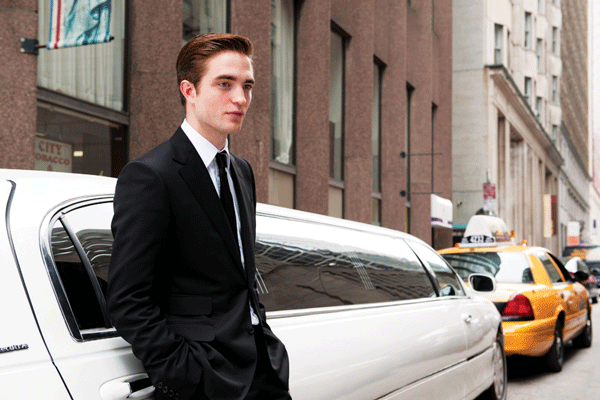
Stuck in traffic: A Wall Street whiz kid loses his fortune while cruising around town, in David Cronenberg’s “Cosmopolis.”
Anthology’s Auto-Cinema series contemplates the car
BY SEAN EGAN | With the unveiling of Citi Bike, the MTA increasing subway fare and the seasonal rise in gas prices, the best way to get from point A to point B has been at the forefront of many New Yorkers’ minds — making this a particularly relevant time for “Auto-Cinema.”
Curated by Anthology Film Archives, the week-long collection of previously released films that prominently feature automobiles scrutinizes the function and significance of the commonplace machine most take for granted — and in doing so, it examines the automobile’s role in cinema, as well as society at large.
The series was reportedly inspired by the relatively close release dates of two of 2012’s most interesting auteur-driven movies: David Cronenberg’s “Cosmopolis” and Leos Carax’s “Holy Motors.” While the films differ wildly in tone and content, they both featured inscrutable protagonists who spend a large portion of the film riding around sprawling metropolises (New York and Paris, respectively) from the back seat of state of the art stretch limousines. With this coincidence sparking their interest, Anthology dug deeper to find other films raising similar thematic questions through the lens of the car.
In “Cosmopolis,” writer-director David Cronenberg — the master of body horror and all things icky and technological — adapts Don DeLillo’s 2003 novel about a gifted twentysomething Wall Street financial wizard, Eric Packer (Robert Pattinson), who loses his fortune over the course of the day while stuck in traffic. This simple summary does not do Cronenberg’s slow burn of a film justice, as he uses the limitations of his setting to make a deeply paranoid and unsettling picture. Through claustrophobic camerawork, moody lighting and vaguely science-fiction-y iconography, the limo becomes a hermetically sealed capsule, which keeps out the (literal) anarchy of the outside world (and, in the process, potently uses the vehicle as a metaphor for the modern world’s over-reliance on gadgetry).
These themes of isolation and lack of concern for the world are aided immeasurably by Pattinson’s distant and detached performance as the nonchalant Packer, and the inscrutable, steely grimace he wears for the majority of the film. Both incredibly relevant to today (especially with its presentation of the “one percent” and Occupy-like protests), and timeless in its ideas, “Cosmopolis” is highly recommended viewing.
No less potent a rumination on the dangers of technology now than when it came out, Cronenberg’s 1996 psychological thriller, “Crash,” is also an official selection of the Auto-Cinema series. Highly controversial upon release (due to its twisted and explicit portrayals of sex and violence), Cronenberg again uses the automobile to criticize the modern world and unsettle the audience. Set in a future not unlike our own, the film follows a ragtag cast of characters (headed by James Spader and Holly Hunter) who become sexually aroused by violent car crashes and the destruction they produce. The film is classic Cronenberg, liberally and thoughtfully intertwining sex and violence, and the human with the mechanic — all while conjuring up disturbing imagery that would make even the bravest filmgoer squirm (the “leg scene” in this film is definitely not for the faint of heart). “Crash” uses the automobile as an example of how people in the modern world frequently fetishize machinery and technology to the detriment of the ones they love and society as a whole.
If Cronenberg’s films show the car to be indicative of a larger, more sinister problem with technology eating at the heart of society, Carax’s “Holy Motors” is a vibrant and inventive movie about the transformative potential of the automobile and technology. The plot of this mind-bending, genre-hopping, whacked-out film — if you can call it a plot — concerns a man named Oscar (Denis Lavant), who uses his limo as a state-of-the-art changing room to get into elaborate costumes while riding to various “jobs” in Paris that seemingly require him to perform as a variety of distinct characters, for some mysterious and/or unknown purpose or audience. This conceit allows for the film to gleefully shift tones on a dime, careening with aplomb from slapstick comedy, to intimate drama, to violent thriller to full-scale musical numbers. The car becomes a symbol with a multitude of potential meaning: as the place where we are most vulnerable and in touch with our real selves, as a place of reinvention where we shape our identities, or as the backstage to some grand scale theatrical performance. These are just some of the heady themes one can mull over once this wickedly clever and visually stunning film has faded from the screen.
Celebrated Iranian filmmaker Abbas Kiarostami, like Cronenberg, has a pair of features being screened for the Auto-Cinema program. “Taste of Cherry” (1997) and “Ten” (2002) both take place almost exclusively within the confines of normal cars, but the scope of the ideas Kiarostami explores within them know no limits. “Taste of Cherry,” a winner of the prestigious Palme d’Or, concerns a man who wishes to commit suicide as he drives around Tehran, interviewing potential candidates for people to bury his body. With its long conversations and beautifully shot landscapes, the film becomes a meditation on life and death, with the car also acting as a place for open dialogue between individuals. Stripping away the sumptuous cinematography of “Taste of Cherry” in favor of a couple of dashboard mounted digital camcorders, “Ten” explores similar themes, focusing exclusively on a series of conversations between a young mother and her various passengers. These conversations span from the incredibly personal ones with her obstinate son, to encounters with friends, sex workers and a religious old woman. Kiarostami here shows the car to be a space where people can debate and examine societal norms and the “big questions” (particularly those concerning women in society and sexual politics), as well as have intimate and honest conversation with others, including family.
The festival is rounded out by a few more screenings of rare works held by Anthology. An impressive short film program promises to be interesting, featuring five films examining the automobile from different social, political, and environmental lenses. Chip Lord’s feature length video, “Motorist,” features Richard Marcus as a driver on a road trip, commenting on his surroundings and the nature of cars, while director Saul Levine presents a conversation in a car with his friend Katha Washburn in a single 82-minute take, as part of his “Driven” video series. These last selections help to ensure Anthology’s Auto-Cinema program will be expansive, thought-provoking and something audiences can’t find anywhere else.
AUTO-CINEMA
June 19-25
At Anthology Film Archives (32 Second Ave., at E. Second St.)
Purchase tickets: $10 ($8 for students/seniors) at the box office
For info: 212-505-5181 or anthologyfilmarchives.org

















